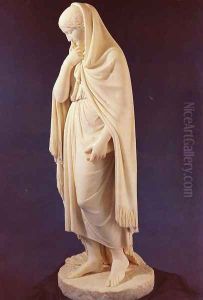Benjamin Edward Spence Paintings
Benjamin Edward Spence was a British sculptor born in 1822 in Liverpool, England. He was a notable artist during the 19th century, primarily recognized for his work in marble sculpture. Spence demonstrated a keen interest in art from a young age, which led him to pursue a career in sculpture. His early education in the arts began in his hometown, but his talent soon necessitated a move to a more prominent center for the arts.
In pursuit of further artistic development, Spence relocated to Rome, Italy, which was a hub for artists during that era. Rome presented him with the opportunity to study ancient classical art and Renaissance masterpieces, which greatly influenced his style and technique. Spence became part of a community of expatriate artists and was particularly associated with the British and American artists' colony in the city. While in Rome, Spence honed his skills and began to gain recognition for his work.
Spence's sculptures often reflected the neoclassical style, which was prevalent among many sculptors of his time. He worked on various subjects, including mythological themes, portraits, and funerary monuments. His works were characterized by their detailed execution and the smooth finish of the marble. Spence was also known to have produced a series of idealized female figures which were well received in artistic circles.
Despite his success in Rome, Spence maintained connections with the British art world. He exhibited his works at the Royal Academy in London and received commissions from British patrons. Spence's sculptures were appreciated for their beauty and craftsmanship, and they contributed to the Victorian taste for classical art.
Benjamin Edward Spence's career was cut short when he died at the relatively young age of 44 in 1866. His sudden death was a loss to the artistic community, and he left behind a body of work that continues to be studied and admired. Spence's sculptures can still be found in various collections and museums, serving as a testament to his skill and dedication to the art of sculpture.
